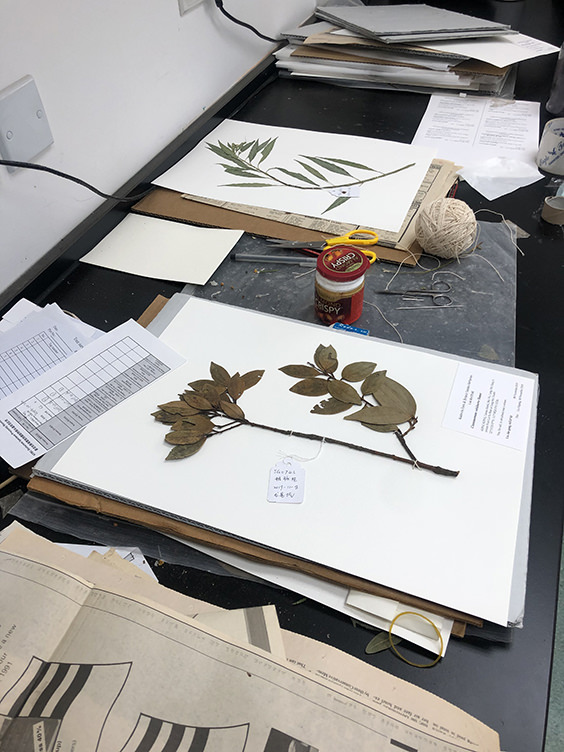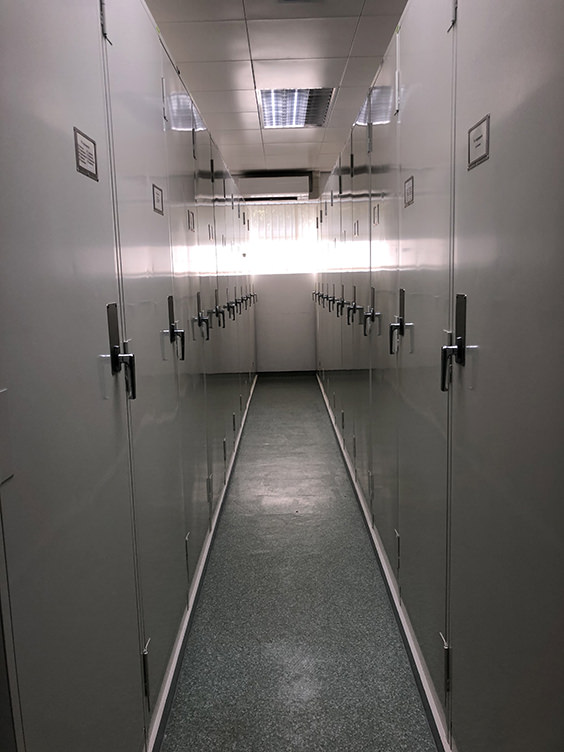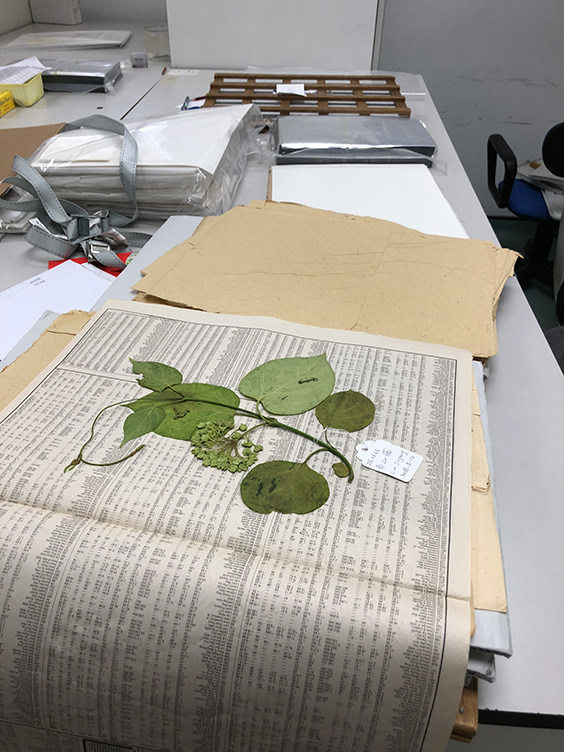

A herbarium is a repository for plant specimens used in scientific study. Plant specimens underpin the study of botany, particularly plant taxonomy and nomenclature. Descriptions of plant species new to science and the periodic review of all species belonging to particular genera require the examination of specimens held in herbaria. And the compilation of complete floras or checklists for a specific country demands that all herbarium specimens collected in that country are studied and formally identified.
The KFBG herbarium (denoted KFBG in Index Herbariorum, http://sweetgum.nybg.org/science/ih/) was established by Gloria Barretto and Sian Jones in 1990. It occupies part of our Natural History Building and houses more than 19,000 pressed herbarium specimens. All specimens are arranged linearly following modern plant classification systems (APG system for angiosperms, the Christenhusz system for gymnosperms and PPG I system for ferns). Our collection of over 2000 bryophyte specimens are arranged in alphabetic order.
Gloria Barretto was a self-taught botanist specialising in orchids. She started collecting specimens throughout Hong Kong in the 1970s and invited Professor Shiu-Ying Hu of The Chinese University of Hong Kong to identify them for her. Based on these collections, the two described a number of species new to science. Barretto also used her specimens to compile the first checklist of plants growing in KFBG. Her collection and checklist remain important references for botanical studies in Hong Kong.

Since then, many Chinese botanists have worked on the flora of Hong Kong. Professor Chang Hung Ta of Sun Yat Sen University in Guangzhou entrusted an important collection of Camellia, Eurya and Ternstroemia species from Hong Kong Island to KFBG in 1985, and Chen Te Chao, Liu Jian-Liang, Wang Xue-Wen and Chen Bing-Hui from South China Botanical Garden visited the territory in 1987 and 1988 at KFBG’s invitation, resulting in the acquisition of more than 260 specimens. By 1990, the need for a dedicated facility for the storage and study of the growing collections was self-evident, and all specimens were curated in cabinets in 1990. Wang Xue-Wen and Sian Jones began cataloguing all plant species found in KFBG at this time, and together they added more than 3700 specimens to the herbarium.
Since 2000, KFBG has run a very active programme of biodiversity surveys across South China, including Bawangling in Hainan, Dachouding in Guangdong and Shiwandashan in Guangxi. During these expeditions, KFBG’s Ng Sai-Chit collected around 800 herbarium specimens and deposited them in our herbarium. To these, he added several hundred accessions collected in Hong Kong. The herbarium also features important collections of the ferns of Hong Kong amassed by herbarium curator Wicky Lee in collaboration with Professor Wu Shiew Hung of South China Botanical Garden in the late 1990s. Building on this, Yan Yue-Hong of Chenshan Botanical Garden in Shanghai deposited more than 1200 fern specimens collected in Hong Kong from 2010–2011.
Our herbarium building was renovated and fitted with custom-made cabinets in 2014. R packages ‘herblabel’ and ‘plantlist’ were written by our herbarium staff to facilitate label preparation and curation. The collections continue to grow, notably with the addition of specimens of the more than 50 plant species that our botanists have newly recorded in Hong Kong since 2010.

Herbarium specimens are not only a critical resource for taxonomy, they are also central to biodiversity conservation. To assess the conservation status of a species, biologists need a number of occurrence records to delineate a species’ range, for example, and the occurrence records compiled from herbarium specimens can be used to model habitat suitability and infer the potential distribution of a species.
It also serves as a fabulous training and educational facility in which professionals, students and volunteers can learn about the documentation and study of plant diversity for a wide range of purposes, from botany and conservation, to history, art and design. Since 2025, a series of herbarium specimen-making workshops have been held at the KFBG Herbarium. Participants learned the fundamentals of herbarium techniques, key aspects of specimen curation, and more. For more details, please visit: The Art and Science of Documenting Biodiversity.
Visiting
We welcome visitors to examine herbarium specimens inside the herbarium by appointment only. Our opening hours are 09:00–16:30, Monday to Friday (except Public Holidays). Please contact our curators in advance.
Contact
Dr. Jinlong Zhang: jlzhang@kfbg.org
Huiling Zhu: hlzhu@kfbg.org
Further reading
- Find the most accurate plant names: from mobile apps, specimens to literature
- The Art and Science of Documenting Biodiversity: Making Plant Specimens in the KFBG Herbarium
- Barretto, G. 2004. Check List of Plants at Kadoorie Farm and Botanic Garden. Kadoorie Farm and Botanic Garden, Hong Kong.
- Zhang, J.L. 2017. Plantlist: Looking up the status of plant scientific names based on the plant list database. R package version 0.3.0.
- Zhang J., Zhu H., Liu J., Fischer G.A. 2016. Principles behind designing herbarium specimen labels and the R package herblabel. Biodiversity Science 24:1345–1352.
- Liu, J., Hang, K. Y., Wong, C. K., Hon, C. H., Williams, C., Mar, S. S., Lee, Y. L., Zhang, J., & Fischer, G. A. (2021). Seventeen newly recorded species to the flora of Hong Kong, China. Journal of Tropical and Subtropical Botany, 29(2), 123–131.
- Zhu, H., Liu, J., Zhang, J., Hang, K.Y., Yeung, W.K., Fischer, G.A. (2018). Ten newly recorded taxa to the flora of Hong Kong, China. Guihaia 38: 1221–1228.
- Zhu, H.-L., Liu, J.-G., Wong, C.-K., Williams, C., Hang, K.-Y., Zhang, J.-L., & Gale, S. W. (2023). Additions to the Flora of Hong Kong. Subtropical Plant Science, 52(1), 76–83.
